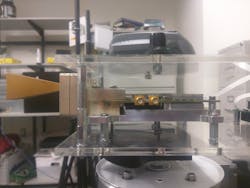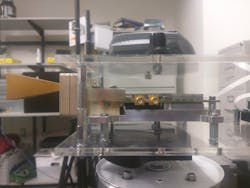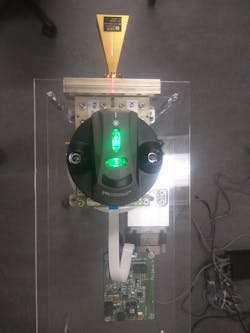Research centers such as NYU WIRELESS are paving the way for Fifth-Generation (5G) wireless systems through their work in the millimeter-wave radio spectrum. The next generation of mobile services will bring higher speed and lower latency. The Federal Communications Commission (FCC) has already taken an important step by proposing new flexible rules for the 28-, 37-, 39-, and 64-71 GHz bands. This first step will certainly help the development of 5G in the United States.
Since 2012, NYU WIRELESS has been focusing on mass-deployable wireless devices across a wide range of applications and markets. The millimeter-wave wireless networking research “is a multidisciplinary effort that includes people from different disciplines,” says Professor Sundeep Rangan, the center’s new director. “For example, there are people from NYU School of Engineering Electrical and Computer Engineering Department thinking about mobile computing and processing data over the network. Also, there are people from NYU Langone School of Medicine looking at the health aspect of millimeter-wave, while the NYU Stern School of Business is focusing in how millimeter-wave will be used by businesses and regulated by the FCC.
“Right now, there is a huge demand for the current cellular system,” Rangan continues. “Mobile data demand keeps growing, and millimeter-wave backhaul has an enormous potential for building very high-capacity networks to deliver faster higher-quality video and multimedia content.”
NYU WIRELESS has announced plans to build an advanced programmable platform to rapidly design, prototype, and validate technologies that are vital for the millimeter-wave radio spectrum, which is potentially key to launching the next ultra-high data-rate generation of wireless communications (5G). “Many technologies are involved in 5G; certainly millimeter wave will be an important component of 5G that is going to coexist with other technologies,” notes Rangan.
The millimeter wave occupies the band of spectrum between 30 and 300 GHz. Higher frequencies mean higher data rates with a short transmission-range limitation. But this short range can be used as an advantage by using small base stations (picocells or metro cells). Base stations can be connected through millimeter-wave links using different multiple-input multiple-output (MIMO) configurations.
Millimeter-Wave Test Equipment
Current millimeter-wave prototyping systems use directional horn antennas, which are sometimes mounted on mechanically rotatable gimbals. In this case, they are mounted on to the millimeter-wave RF heads (Fig. 1). Aditya Dhananjay is a post-doctoral student at the Tandon School of Engineering at NYU working on prototyping next-generation millimeter-wave systems (Fig. 2). He emphasizes the importance of using the right test equipment for pioneer research technologies, as mechanical systems are too large and slow for mobile applications. Specifically, Dhananjay notes, “To design and validate a new software-defined-radio (SDR) platform technology in the millimeter-wave spectrum, it is necessary to use test equipment with high capabilities that will be able to handle such an enormous amount of data with precision and very low latency.”
As announced by NYU WIRELESS, the public testbed will use a new SDR platform that will integrate an electrically steerable phased array with no physically moving parts and near-instantaneous steering. This platform will help engineers speed the improvement of millimeter-wave systems by building millimeter-wave links, running experiments over the air, and being able both to validate designs and test their performance.
This research includes cooperation with two companies. Sibeam will provide the phased-array antennas that will enable a powerful, flexible, and programmable platform for the design and validation of next-generation millimeter-wave systems. National Instruments (NI) will provide a high-bandwidth and massive baseband processing system to create millimeter-wave prototypes capable of high data rates and very low latency.
FCC
Meanwhile, NYU WIRELESS was very influential in persuading the FCC to consider the usage of higher-band spectrum for 5G. Recently, the FCC proposed new flexible rules for four different bands of high-band spectrum above 24 GHz, which are designed to lay the foundation for 5G networks in the U.S. market. This action will facilitate access to millimeter-wave spectrum, aid in the development of a flexible millimeter-wave spectrum policy, and encourage wireless innovation. The specific proposed bands include:
- 27.5 to 28.35 GHz (to be known as the 28-GHz band)
- 38.6 to 40 GHz (to be known as the 39-GHz band)
- 37 to 38.6 GHz (to be known as the 37-GHz band)
- 64 to 71 GHz
Making these bands available will required a variety of authorization schemes, including traditional wide-area licensing, unlicensed, and a shared approach that will provide access for both local-area and wide-area networks. These proposed rules are an opportunity that could benefit consumers and businesses alike, thus benefitting the U.S. economy.
For businesses that can leverage this technology and spectrum, the FCC’s move is significant. “With the future development of a millimeter-wave network and due to the nature of the millimeter-wave spectrum, spectrum allocation criteria will be different,” says Rangan. “NYU WIRELESS is working with an economist (Nicholas Economides) with the help of the Natural Science Foundation to evaluate the economic aspects of millimeter-wave spectrum and resource management.” Such research will help businesses determine how the new technology will be used by businesses and regulated by the FCC.
Given his work on leading-edge research, Rangan has other thoughts about the future of 5G. “I picture the future of 5G as only increasing,” he says. “Mobiles will have bigger data rates and much more phones are going to be connected to PCs, the cloud, etc.” As it was when 3G and 4G were first rolled out, Rangan notes that it is hard to tell right now what, if any, applications will be at a disadvantage when 5G is implemented. Yet millimeter-wave research has provided many excellent and useful results. Even though 5G is in its early stage of development, the future looks very optimistic.
Looking for specific products? Please visit SourceESB.
About the Author
Maria Guerra
Power/Analog Editor
Maria Guerra is the Power/Analog Editor for Electronic Design. She is an Electrical Engineer with an MSEE from NYU Tandon School of Engineering. She has a very solid engineering background and extensive experience with technical documentation and writing. Before joining Electronic Design, she was an Electrical Engineer for Kellogg, Brown & Root Ltd (London. U.K.). During her years in the Oil and Gas Industry she was involved in a range of projects for both offshore and onshore designs. Her technical and soft skills bring a practical, hands-on approach to the Electronic Design team.


